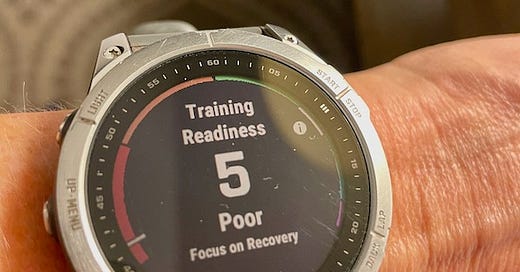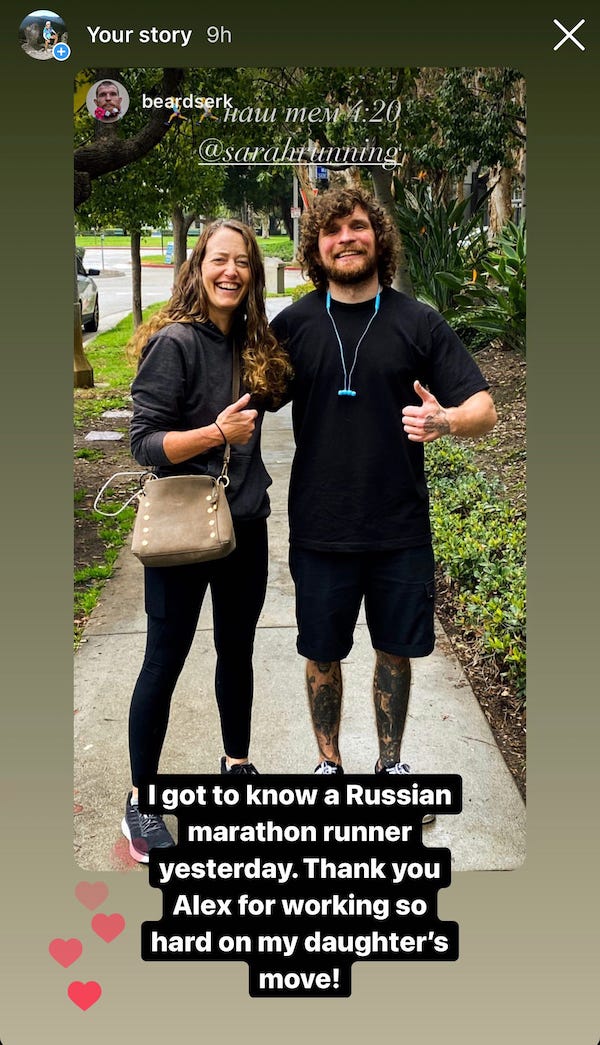A New Year's Move
Advice on training through stress plus ideas for running goals in the new year
Hello and happy new year! This is a bonus post for paid subscribers. If you’re one of them, please read to the end for the date and link for the online meetup later in January.
It’s New Year’s Eve, and I’m ending the year feeling trashed even though I’m spending tonight quietly at home. My watch, which gauges sleep and training readiness, tells me what I already know by feel: I need to rest and recover.
I did not overdo running. On the contrary, I ran minimally this past week (6 miles Tuesday with some speed intervals, 4 miles easy Wednesday, another 4 easy on Friday), with no strength workouts. But I experienced a life stressor, and last night, after passing out around 9 p.m., I woke just after 2:30 a.m. and never fell back asleep.
Without going into details that I’d rather keep personal, the stress mostly but not entirely involved packing up my daughter’s apartment and, with the help of movers, transferring all her belongings into a fixer-upper condo that’s going through a remodel and not quite ready for occupancy. (I shouldered the work of the move because she couldn’t take the days off from her job.)
I tried to practice what I preached in my post last Wednesday—being mindful of the present, enthusiastic, and less of a control freak—and tried to role model optimism and calm. But the packing-cleaning-moving process exhausted me by pushing maternal buttons of worry for my daughter, along with financial concerns. Her living situation for the short term is chaotic, messy, dusty, and full of myriad expensive problems related to the renovation.
I share this partly to remind you all that life stressors such as moving, a job change, illness, or breakups can dramatically affect “training readiness” and drain your “body battery,” as your Garmin watch might quantify. I encourage you to lower your expectations on how you perform and what you can or should accomplish when your body is in this state.
I made plans for a New Year’s Day group run in the morning, hoping to log at least 20 as prep for the Black Canyon 60K in February, but the fresh snow combined with my current fatigue means I’m going to head out—or stay in on the treadmill—with no commitment to a specific distance or time, just go by feel. I’ll save a depleting long run for when I’m feeling fresh and psyched for it (as Jason Koop wisely advised in this recent post where he states, “Determine when you are going to be the most fresh and put your hardest runs there. Avoid doing your hardest runs when you are the most fatigued.”)
Mostly, however, I shared the story above to end with the part that “moved me” (sorry, bad pun). Three guys from Russia showed up from the moving company. The heavily tattooed and bearded one noticed my Hokas and the fact I looked dressed to run, so through the other guy who could speak English better, he asked if I’m a runner. We proceeded to talk running and coaching, and he revealed he’s a serious marathoner who has run Boston. He seemed excited to meet me when I showed him my book, and he asked me to be in his Instagram story. Turns out he makes impressive Instagram Reels and has a large following.
He said he moved here four months ago because he’s Russian and his wife is Ukrainian. That’s all I needed to hear to understand they’re escaping the war. That really puts our struggles into perspective, doesn’t it?
The three guys worked incredibly hard and patiently, helping me in every way possible, and never complaining about the three flights of stairs in the condo. I thought the job would take four or five hours, and it ended up being nearly eight. After I paid, and one of them thanked me because I had bought them lunch and tipped them, he stoically said, “Now we go to second job.” I had no idea they had a second move scheduled right after ours, which they would start after 5 p.m.
I thought about them when I was stressing out and insomniac last night—about all they’ve been through, their work ethic, and how kindly they treated me when I needed that kind of support on a challenging day. Today, I felt like a nicer person in the airport, trying to act with kindness toward anyone near me, all because of that moving crew, especially the runner.
I came upon a new year’s essay from early 2021, which I wrote for my UltraRunning magazine column, and I’m excerpting it here:
Whether it’s running a first 50-miler, going for the Grand Slam or trying a 200, we gain motivation and pin hopes on our annual race calendar. But 2020 taught us the risk of counting on ultras for fulfillment. Having suffered the deep disappointment of these events’ cancellations, don’t forget what 2020 taught us—that you can and should find satisfaction from this sport in ways that don’t involve crossing a finish line.
With that in mind, I compiled the following challenges to enhance your ultrarunning experience in the coming year. Keep planning and training for ultras—but also try to diversify your athleticism and goals, so that you have a source for stoke if you can’t race.
Try a solo challenge. While several ultrarunners embarked on Fastest Known Time challenges in the past year, FKTs aren’t for everybody. Some of us aren’t built for speed, so attempting to be the fastest on a segment is a nonstarter. Thankfully, Aravaipa Running and other race directors invented some creative challenges in 2020, beyond the FKT, which anyone can do on their own. You don’t have to sign up for an organized virtual event (unless you want the schwag and online camaraderie that go with it); these challenges can be done anywhere, anytime, just for the heck of it.
Take the vertical challenge, for example. Inspired by a virtual vert challenge organized by Aravaipa, I spent a full week logging as much vertical gain as I could. Speed didn’t matter, mileage didn’t matter—just ascent. I thrived on the challenge and went much higher and farther in a week than I ever imagined I would (179 miles and nearly 59,000 feet for the equivalent of a double Everest).
Many became inspired by Rickey Gates’ “every single street” attempt to run every street, or every trail, in their area. Others were drawn to the perennial appeal of streaking, running every single day. One of my friends designed a 100-mile trail route in her region and ran it over three days. They all discovered how these personal challenges give structure and motivation when racing isn’t an option.
Try a new sport. Crosstraining can help prevent burnout and provide a welcome break from the specificity of training for ultras.
Learning something new will reconnect you with the beginner’s mindset—the way you felt when you first became a runner. I experienced this last winter when I took up downhill skiing and advanced to the point where I could feel the thrill of a good ski run. I also started yoga with the help of online yoga videos. It’s humbling yet exciting to develop a new skill, and it’s a potent reminder that there’s more to life than running.
Mentor a younger, newer runner. If you haven’t felt the “runner’s high” in a while, then try running next to inexperienced runners, encouraging them, sharing your knowledge, and witnessing their excitement when they run on a trail for the first time. You’re almost guaranteed to feel a contact high. I’ve had the joy of coaching middle-school students in cross-country running and mentoring teenagers through a program called Running for a Better Oakland. You can find mentorship opportunities through a local running club or through national programs such as Girls on the Run.
Read great stories about the sport. The burgeoning niche of ultrarunning memoirs is a fountain of inspiration. Ever since Dean Karnazes wrote his bestselling Ultramarathon Man in 2005, ultrarunning writers have produced memoirs that entertain, teach, and motivate. If you are in a running rut, then curl up with a good ultrarunning book, and chances are you’ll feel like running again when you finish it. A few of my favorite memoirs: Katie Arnold’s Running Home, Scott and Jenny Jurek’s North, Cory Reese’s Nowhere Near First. How about challenging yourself to read 12 running-related books, one a month, in the coming year?
Take a class. Everyone should aspire to be a lifelong learner. Instead of just going through the motions of ultrarunning, try to be a student of the sport—that is, learn as much as you can, to continually enhance your understanding. In addition to reading, consider taking a class. Online classes in exercise physiology and nutrition can bolster your performance (coursera.org is a good place to find online classes from reputable universities). In-person classes in wilderness first aid offered by NOLS and others are prudent for anyone who seeks adventure on the trails.
Run for a cause. It’s easy to feel charity fatigue (I remember rolling my eyes at the umpteenth Team In Training fundraising email I received years ago). But running to raise awareness and funds for something you care about is a powerful motivator. When I trained for a stage race across public land in the Southwest, I used the opportunity to spread awareness about how those lands are threatened and to raise over $10,000 for a nonprofit that works to protect them. When the pandemic set in, a friend of mine ran to raise money for an emergency relief fund for workers impacted by Covid-19. Run for a cause, and you’ll run out the door with a greater sense of purpose.






